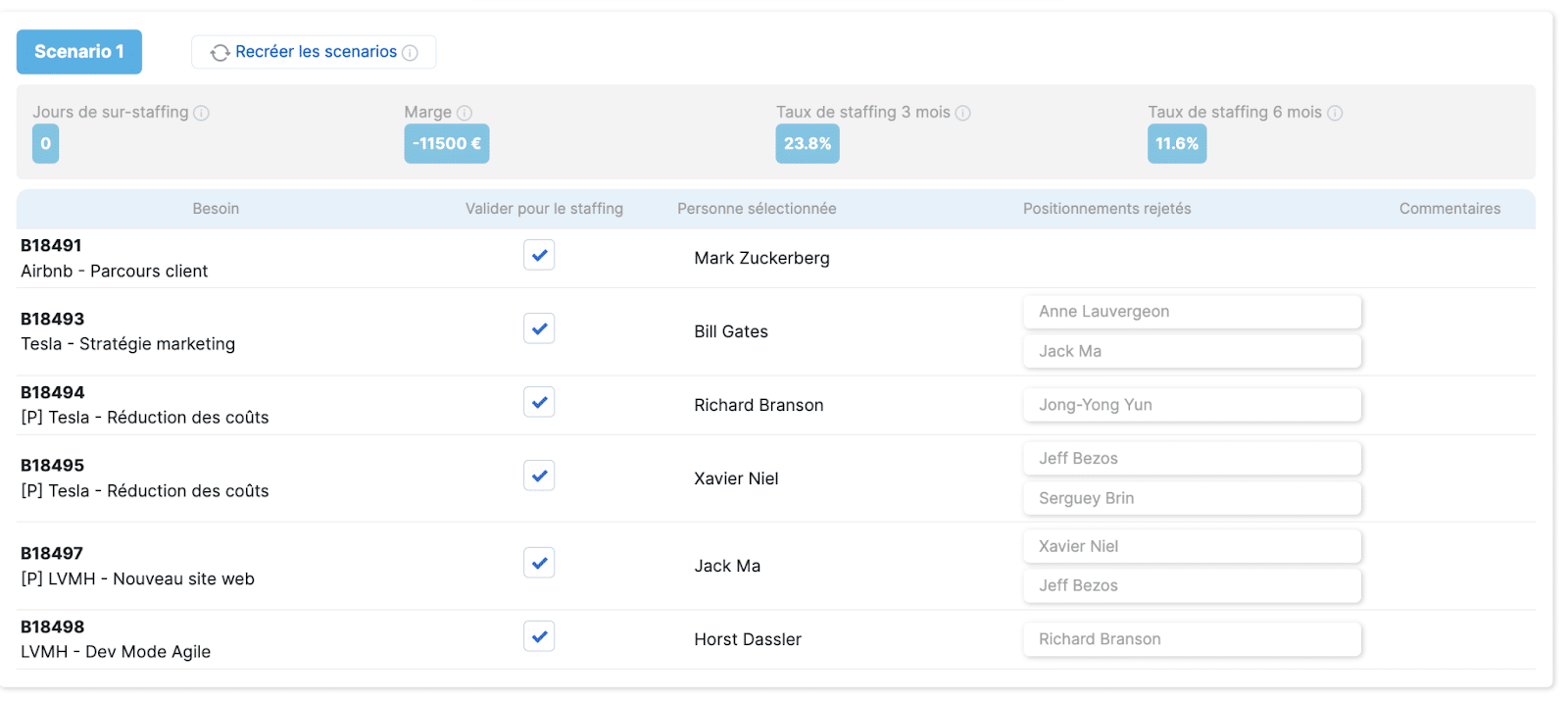Provisional project planning: definition, role and methods

In service companies in France, provisional planning has become an essential standard for managing costs, resources and profitability in a multi-project environment. The success of a project is not only based on a good initial framework : it depends above all on the ability to anticipate, adjust and make decisions at the right time. However, many teams are still operating with outdated information or forecasts updated too late, creating delays, overloads and financial drifts.
This gap between project preparation and implementation generates a permanent conflict: operational teams lack visibility, management cannot anticipate the margin, and Human Resources struggle to plan recruitment.
Faced with this complexity, the provisional planning becomes a central tool: it links operational planning, resource planning, costs, forecasting and financial management in the same decision-making logic. Used properly, it makes it possible to align all stakeholders and avoid excesses in loads, deadlines or margins.
In this guide, we detail how to build, monitor and operate a provisional planning : its definition, its challenges, its risks, advantages and disadvantages of provisional planning, its place in financial management, the methodological steps and the essential tools.
What is a provisional schedule?
Provisional project planning: definition
The provisional project schedule organizes the progress of the project over time.
- What tasks?
- What milestones and objectives?
- What workload?
- What costs?
- What resources, in what order, and in what timeframe?
This document evolves throughout the project as unforeseen events, scope adjustments, or delays change the remaining load.
What is its role in project planning?
The provisional schedule serves as the basis for operational and financial management. It allows, in line with the actual progress of the project, to:
- Update the remaining to be done;
- Recalculate the remaining schedule;
- Produce a reliable operational and financial forecast;
Each update of the schedule enlightens you on the decisions to be made: how to adjust loads, how to (re)allocate resources, which tasks to prioritize, how to anticipate delays... This gives teams a common benchmark to understand and measure the impact of a gap, and adapt the landing before it's too late.
Does the provisional schedule fit into the project schedule?
The project timeline provides a macro view of your project. It describes the major phases, main tasks and major deadlines.
The provisional schedule goes down to the operational level. It describes who is involved, when, in what order, on what load and for which deliverable. This granularity is essential to move from a strategic vision to an operational vision.
What is the difference between a provisional schedule and a retroplanning?
A provisional schedule describes how the project should unfold over time. It is a projection that allows the teams to know how the activities will be carried out, what the workload will be and the resources required. It is a dynamic management tool. It adapts over time, integrates contingencies, reassesses the rest to be done and highlights the impacts on deadlines or profitability.
Retro-planning, on the other hand, responds to a different logic: it starts with a fixed delivery date, reconstructs the steps backwards and secures compliance with the deadline by controlling room for manoeuvre and dependencies. It is a time framing tool that starts, secures a fixed deadline that starts from the end date to define the intermediate steps.
Why should you make a provisional schedule?
The different challenges of predictive monitoring
The provisional schedule translates each contract or provisional workload plan into dated and measurable actions by all teams. It aligns the actions of the PMO, Delivery Manager, and consultants. It also provides the CEO with a consolidated view of the portfolio, including an overall forecast consistent with actual capacity.
This includes the need for resources, budgets and deadlines. The COO thus has a dynamic RAF to manage several projects simultaneously without the risk of saturating the teams. For HR, the provisional planning becomes a real human resources planning : they gain visibility on the workload and periods of absence, which are essential for planning recruitments and replacements, while the COO adjusts the resource planning before saturation. Consultants also benefit from better visibility into their future workload.
A regular update of the information makes it possible to compare the forecast with the actual, and to adjust the remaining work to be done (RAF) and the forecast.. This data highlights gaps for the COO and allows the PMO to detect drifts. The management controller relies on this forecast to project a consistent margin.
Project tracking data feeds into invoicing, cash flow, and reporting. The CFO depends on a reliable forecast to stabilize cash flow, invoicing and financial landing. This consolidation reduces the discrepancies between actual progress and invoicing.
The forecast helps management and HR to arbitrate between training, subcontracting or recruitment. It makes it possible to identify missing skills and periods requiring external reinforcement. The Business Manager also relies on this data to align sales commitments and delivery capacity.
What are the risks associated with the lack of provisional planning?
Monitoring a project on a day-to-day basis is not easy. These change rapidly, making any forecast obsolete if it is not revised continuously. Each change in scope, postponement of deliverables or unforeseen event immediately modifies the remaining load. Without regular updates, the COO loses the actual reading of the load and the PMO can no longer anticipate drifts, which appear too late to be corrected effectively.
Unfortunately, the rest of the work is rarely reliably updated, especially when teams don't have a dedicated tool. This lack of complete data degrades the quality of the forecast and complicates the work of the PMO as well as that of management control, which must manage with inaccurate projections.
And as soon as these updates are delayed, the link between operational and financial planning is broken. The CFO finds himself with a gap between progress and invoicing, inconsistent margins and a cash flow that is difficult to stabilize.
Finally, multi-project and multi-team management remains complex in the absence of a unified tool. Delivery managers have to arbitrate blindly between competing projects, and the CEO lacks consolidated visibility to understand load, risk and growth trajectory.
Who can make a forecast?
The development of a provisional plan is essentially a task that mobilizes several functions, each of which provides part of the data necessary for management:
- The project manager / PMO builds the schedule, organizes the activities and updates the rest to be done.
- The Delivery Manager arbitrates resources and manages conflicts between projects.
- The CFO / CFO consolidates economic data and links progress, costs and invoicing.
- The resource planning Manager / Office Manager synchronizes the operational forecast with the actual availability of the teams.
This collaboration guarantees a reliable forecast, capable of supporting tactical decisions (reallocation, prioritization) as well as strategic decisions (recruitment, financial management, portfolio arbitration).
The link between provisional planning, forecasting and financial management
From operational planning to financial forecasting
The provisional schedule forms the basis of the financial forecast. It transforms tasks, workload, and forecasted resources into projected revenue, costs, and margin at completion.
- Each planned activity generates future production.
- When milestones or deliverables trigger invoicing. This production is reflected in projected revenues.
The link between operational planning and budget is therefore direct: a change in scope, a delay in deliverable or a load drift immediately changes the financial trajectory of the project. This link can also be positive: a change of resource, an increase in skills or outsourcing instantly changes the landing.
To obtain a reliable financial forecast, three elements must be linked.
- The remaining costs to be done, which determine the estimated cost and the remaining charge.
- The times achieved, which influence the margin to date.
- Direct expenses that enrich budget consumption (subcontracting, costs, purchases).
Budget planning is based on this link between expenses, costs and deliverables. An inaccurate estimate, a lack of visibility on skills or a poor anticipation of non-billable hours lead to cost deviations. This work feeds directly into the provisional financial plan and the projected cash flow plan : by combining the time to be done and the direct expenses, the finance department can project cash flow, margin and result at completion with a better level of reliability.
Measuring the discrepancies between the actual and the forecast
Without a systematic comparison between what is achieved and what is forecast, deviations remain invisible for too long: delays accumulate, costs drift and margins deteriorate without any alert that can be used by the teams. In service companies, the provisional planning and monitoring of non-billable times go hand in hand: without taking into account internal or pro-bono hours, the forecast is systematically optimistic and the real margin is far from the forecast.
The key KPIs to check if the project progress is being monitored, in terms of deadlines, workload and profitability are:
- The rate of progress: achieved, vs. planned, by milestone and by deliverable.
- The load variance: days consumed vs. planned days, per profile or per team.
- The margin spread: margin to date vs. projected margin at landing.
These indicators are only sufficient if they are part of a real-time management of drifts: regular review of discrepancies, identification of causes (unclear scope, misleading estimates, unplanned subcontracting, misallocated resources), quick decisions on the resource planning, deadlines or scope. In Stafiz, project history, automatic comparison of planned times to actual times and preventive alerts help your teams react before deviations become irreversible.
What are the steps to establish an effective provisional schedule?
The methodological approach
A reliable provisional schedule is first and foremost based on a clear framework.
- Define the objectives, milestones and expected project deliverables and then break down the work according to the WBS ( Work Breakdown Structure) method to finely structure the tasks.
- Estimate the durations and dependencies between tasks : these elements determine, according to the critical path method, the risks of bottlenecks and the room for manoeuvre.
- Identify critical resources: rare skills, high-demand profiles, or external dependencies. Rigorous management of needs (recruiting, training or subcontracting) makes it possible to align capacity with forecasts and to secure the operational and financial landing.
Implement planning governance
A forecast is only valuable if it is governed. The first thing to do is to organize periodic reviews of the remaining expenses, to revise the charges, adjust the deadlines and maintain a coherent forecast.
Governance also involves a clear division of roles and responsibilities:
- Who updates the remaining charge?
- Who adjusts the deadlines?
- Who validates the financial impacts?
This transparency strengthens the coordination of the project team, giving everyone a shared vision of priorities, responsibilities and future decisions. It also reduces errors and speeds up decision-making.
You can formalize this distribution by relying on the RACI (Responsible, Accountable, Consulted, Informed) method, in order to clarify who is in charge, who validates and who is simply informed of updates to the provisional schedule.
How to follow and update a provisional schedule?
An efficient provisional schedule is based on continuous and automated monitoring. Connected tools are a great replacement for Excel: they update the remaining work, recalculate the forecast and automatically synchronize loads, costs and availability. This dynamic update guarantees permanent consistency between operational planning and financial management.
The forecast becomes essential as soon as the project makes structuring decisions. To better understand its impact, let's look at the three forms of forecasting that structure decision-making:
- financial forecasting;
- Capacity planning
- risk forecasting.
Financial forecasting
Financial forecasting involves predicting project costs, revenue, and overall financial performance to ensure that projects stay within budget and achieve profitability.
It has many challenges.
- Uncertain cost estimates: Market fluctuations, inflation, and unexpected expenses make accurate cost predictions difficult.
- Overly optimistic budgeting: Many companies underestimate costs and overestimate financial returns, leading to budget overruns.
- Inconsistent financial data: Differences in accounting policies between departments can lead to discrepancies and misaligned projections.
- Goal creep: Expanding the scope of the project beyond initial forecasts can increase costs and resource demands.
Stafiz provides complete budget visibility, resource estimates, and profit margin impact analysis. This allows your teams to track financial performance in real-time and adjust forecasts accordingly.

Provisional planning example: withStafiz, visualize the impact on profit margins.
Resource & Scheduling Forecasting
Resource and scheduling forecasting helps predict resource allocation and project deadlines to ensure that projects are completed efficiently without overloading teams.
- Unreliable resource availability: Employee turnover, skill shortages, and unplanned absences disrupt resource planning.
- Poor workload estimation: Misjudging the time and effort required for tasks leads to inefficiencies and missed deadlines.
- Lack of real-time resource tracking:Without up-to-date visibility, resource allocation can become inefficient, causing delays.
- Conflicting priorities between projects:In organisations running multiple projects, conflicts over resource allocation can slow progress.

Stafiz allows an optimal allocation of resources based on availability, relevance to skills and motivation thanks to "Needs". In order to better visualize all possible allocations of the same resources.
Stafiz enables optimal resource allocation by balancing skills, availability and motivation.
Real-time tracking ensures that teams have an accurate view of resource usage, avoiding scheduling conflicts and inefficiencies.
With the scenario builder, Stafiz makes it possible to batch plan projects with various scenarios that are optimal for resource allocation and ultimately margin.

Risk-based forecasting
Risk-based forecasting focuses on identifying potential risks and creating mitigation strategies to prevent project disruptions.
It is ideal for:
- high-risk industries with frequent regulatory or market changes,
- compliance-oriented projects that require risk assessments and contingency planning;
- Projects with significant financial, operational or lead time risks.
With Stafiz's risk analysis tools, your teams can proactively identify and mitigate risks before they escalate, ensuring smoother project execution and better risk preparedness.
Stafiz automates the updating of the schedule and forecast to ensure that information is always reliable and consistent. Operational data automatically feeds load, costs, and margin, without manual re-entry.
What tools should be used to create a provisional schedule?
Several tools can be used to build a provisional schedule, but their effectiveness varies greatly depending on the complexity of the project and the speed of change in loads.
The Excel provisional schedule is still widely used for the first framing, but it quickly becomes difficult to maintain as soon as projects, resources or milestones evolve. It takes time to update, often relies on senior profiles, and generates a high risk of manual errors. To go further,
The Gantt chart is the most common representation for visualizing dependencies, durations, and activity sequences. Carried out manually or via dedicated software, it provides a structured reading. However, without a connection to the resource planning nor costs, there remains a static schedule that is difficult to keep up to date.
To go further than Excel or Gantt, an online forecasting application allows you to automatically synchronize the resource planning, costs, RAF and times achieved, ensuring reliable and real-time monitoring.
A project management ERP like Stafiz centralises the management of planning, resource planning and time tracking, and connects charges, availability, costs and deliverables in a single forecast.
- Automatic Gantt : the schedule takes up directly from the resource planning and is updated with the times achieved.
- Real-time budget consideration : HR costs, expenses and subcontracting automatically feed the forecast margin.
- Remaining Updates to Update : Stafiz recalculates the RAF and triggers alerts for future deviations, allowing the trajectory to be adjusted before a deviation becomes critical.
A connected and automated tool thus becomes essential to maintain a reliable forecast, especially in multi-project and growing environments.
Questions:
The provisional schedule is the basis of everything: it defines the resources (human and material) and the time necessary to carry out the projects. This data directly feeds into budget planning by estimating labor costs. Once the projects have been completed, the schedule justifies the hours to be invoiced. Finally, by comparing the scheduled hours to the actual hours, it becomes a key tool for managing the profitability of each mission.
A good planning tool transforms the forecast into a dynamic dashboard. Key indicators (KPIs) such as the occupancy rate or the projected load must be configured. Reporting pulls this data to anticipate future performance, while automatic alerts flag budget overruns or underload risks, enabling proactive action.
A forecast is usually in the form of a Gantt chart or a resource table (e.g., consultant schedule). It illustrates the distribution of workloads over time, key milestones, and the resources assigned to each task or project. The objective is to clearly visualize the available capacities and the commitment of the teams over a given period.
The business plan sets the overall strategic and financial vision of the company over several years (growth, investments, profitability). The provisional planning translates this strategy into operational actions: it plans tasks, resources and project costs over the short or medium term. Where the business plan sets the course, the forecast makes it possible to manage what has been achieved, the rest to be done and the forecast.


